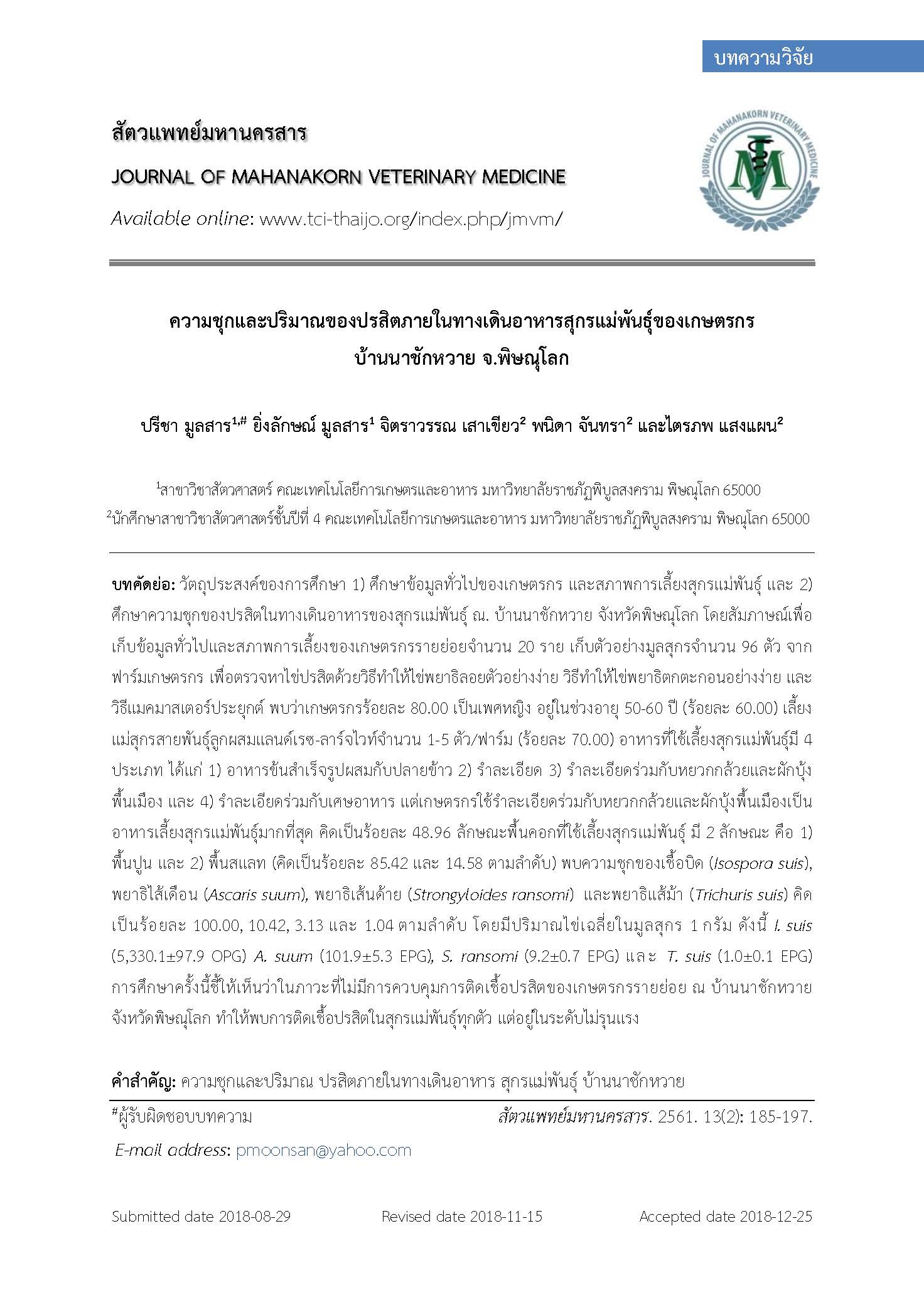Prevalence and Quantity of Gastrointestinal Parasites in Sows of Ban Na Chakwai Famers in Phitsanulok Province
Main Article Content
Abstract
The purposes of the study were 1) to study general information of sow farmers and farming conditions and 2) to survey the prevalence of gastrointestinal parasites of sows in Ban Na Chakwai, Phitsanulok province. The general information and farming condition of 20 farmers were collected by interview. Fecal samples were collected from 96 sows to examined parasite eggs by Simple floatation technique, Simple sedimentation technique and Modified McMaster technique. It was found that most of the farmers were female (80.00 %), in age of 50-60 years (60.00 %), raising 1-5 of Large White - Landrace sows/farm (70.00 %). Several types of mixed feed were used: 1) concentrate + broken rice 2) rice bran 3) rice bran + banana stalk + native water spinach and 4) rice bran + food waste. The mixed of rice bran + banana stalk + native water spinach was mostly used (48.96 %). Sows were raised in different floor pens: 1) concrete floor 2) slatted floor (85.42 and 14.58 %, respectively). The prevalence of Isospora suis, Ascaris suum, Strongyloides ransomi and Trichuris suis were 100.00, 10.42, 3.13 and 1.04 %, respectively. The quantity (average egg/oocyte per gram; EPG/OPG) of five species was I. suis (5,330.1±97.9 OPG), A. suum (101.9±5.3 EPG), S. ransomi (9.2±0.7 EPG) and T. suis (1.0±0.1 EPG). It was indicated that, in small farmer condition without parasite control, the mild prevalence of gastrointestinal parasites in sows were common.
Article Details
References
Barbosa, A. S., O. M. P. Bastos, L. V. Dib, M. P. Siqueira, M. L. Cardozo, L. C. Ferreira, W. T. Chaves, A. B. M. Fonseca, C. M. A. Uchôa, and M. R. R. Amendoeira. 2015. Gastrointestinal parasites of swine raised in different management systems in the State of Rio de Janeiro, Brazil. Pesquisa Veterinária Brasileira. 35(12): 941-946.
Braae, U C., W. Harrison, F. Lekule, P. Magnussen, and M. V. Johansen. 2015. Feedstuff and poor latrines may put pigs at risk of cysticercosis - A case-control study. Vet. Parasitol. 214(2015): 187–191.
Charoenpokaraj, N. 1997. Study on Species and Quantity of Intestinal Helminthes in Fresh Feces of Swine from Piggery Farms (Master’s thesis). Bangkok: The Graduate School Kasetsart University. (in Thai)
Eijck, I. A. J. M. and F. H. M. Borgsteede. 2005. A survey of gastrointestinal pig parasites on free-range, organic and conventional pig farms in The Netherlands. Vet. Res. Commun. 29(5): 407-414.
Idahosa, O. T. 2011. Parasitic Contamination of Fresh Vegetables Sold in Jos Markets. Global J. Med. Res. 11(1): 20-25.
Jiraamonninit, C., S. Wongkamchai, W. Santabutr, S. Loymek, N. Monkong, and H. Nochot. 2006. The Prevalence of intestinal parasitic infections among schoolchildren with annual anthelminthic treatment in Narathiwat province, Thailand. J. Trop. Med. Parasitol. 29: 45-50. Cited by Thathaisong, U. 2012. Important Food-Borne and Water-Borne Pathogenic Parasites in Thailand. Burapha Sci. J. 17(2): 212-220. (in Thai)
Karamon, J., I. Ziomko, T. and Cencek. 2007. Prevalence of Isospora suis and Eimeria spp.in suckling piglet and sow in Poland. Vet. Parasitol. 147(2007): 171-175.
Knecht D., A. Jankowska, and G. Zalesny. 2012. The impact of gastrointestinal parasites infection on slaughter efficiency in pigs. Vet. Parasitol. 184(2012): 291– 297.
Lai, M., R. Q. Zhou, H. C. Huang, and S. J. Hu. 2011. Prevalence and risk factors associated with intestinal parasites in pigs in Chongqing, China. Res. Vet. Sci. 91(2011): e121–e124.
Lindsay, D. S., J. P. Dubey, and B. L. Blaqburn. 1997. Biology of Isospora spp. from humans, nonhuman primates and domestic animals. Clin. Micrbiol. Rev. 10(1): 19–34.
Ngrenngarmlert, W., C. Lamom, S. Pasuralertsakul, R. Yaicharoen, N. Wongjindanon, and S. Sripochang. 2007. Intestinal parasitic infections among school children in Thailand, Tropical Biomedicine, 24: 83-88. Cited by Thathaisong, U. 2012. Important Food-Borne and Water-Borne Pathogenic Parasites in Thailand. Burapha Sci. J. 17(2): 212-220. (in Thai)
Ordoñez, K. N., Y. A. Lim, X. T. Goh, V. G. and Paller. 2018. Parasite contamination of freshly harvested vegetables from selected organic and conventional farms in the Philippines. Pertanika J. Trop. Agric. Sci. 41(4): 1741-1756.
Ózsvári, L. 2018. Production impact of parasitisms and coccidiosis in swine. J. Dairy Vet. Anim. Res. 7(5): 217-222.
Pérez, R. 1997. Organic wastes. In Feeding pigs in the tropics. FAO Animal production and health paper no. 132. Food and Agriculture Organization of the United Nations Rome, Italy. Available online: https://www.fao.org/docrep/003/w3647 e/W3647E06.htm#ch6
Sangvaranond, A. 1998. Veterinary Clinical parasitology. Bangkok: Kasetsart University. 412 pp. (in Thai)
Schubnell, F., S. V. Ah, R. Graage, T. Sydler, X. Sydler, D. Hadorn, and W. Basso. 2016. Occurrence, Clinical involvement and zoonotic potential of endoparasites infecting Swiss pigs. Parasitol. Inter. 65(2016): 618-624.
Sorhasun, S. 2000. Study on Prevalence of Parasitic Protozoa In Faeces from Swine Farms (Master’s thesis). Bangkok: The Graduate School Kasetsart University.
Unjit, K., J. Wattanamethanont, K. Mohkaew, S. Supawan Ngamjiteua, P. Tablerk, and S. Hinjoy. 2012. Prevalence and risk factors of internal parasite among pigs in Nan province during January – April 2011. Thai-NIAH eJournal. 7(1): 9-20.
Waikagul, J., S. Krudsood, P. Radomyos, B. Radomyos, K. Chalemrut, and P. Jonsuksuntigul. 2002. A cross-sectional study of intestinal parasitic infections among schoolchildren in Nan Province, Northern Thailand. Southeast Asian Journal of Tropical Medicine and Public Health, 3: 218-223. Cited by Thathaisong, U. 2012. Important Food-Borne and Water-Borne Pathogenic Parasites in Thailand. Burapha Sci. J. 17(2): 212-220. (in Thai)
Yenjai, P., S. Boonchue, C. Boonshuyar, and T. Saiwichai. 2015. Prevalence and factors related to parasite contamination in swine farm effluent from Photharam district, Ratchaburi province. Proceedings of the 12th KU-KPS Conference, Kampaengsaen, Thailand, 8-9 December 2015: 167-173.


